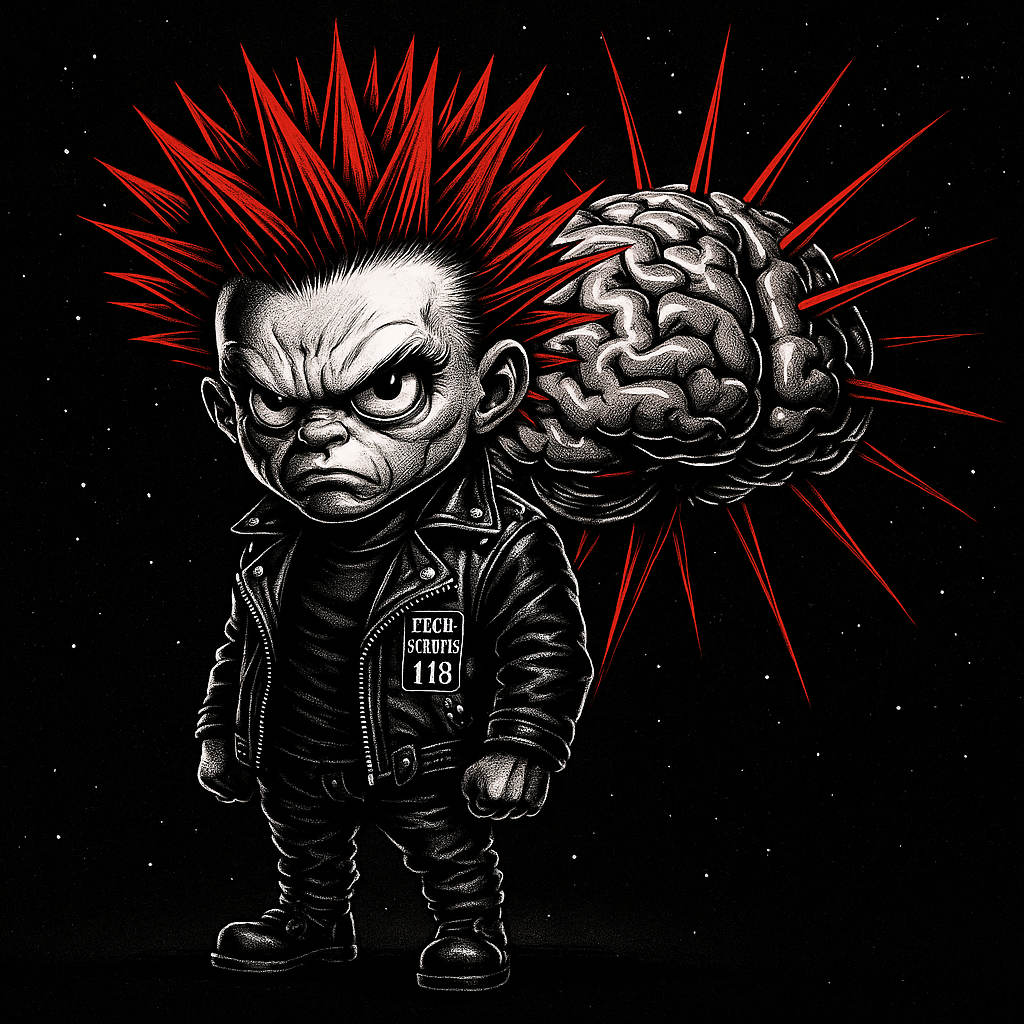Past the Hype: SpikingBrain‑7B (Qwen2.5‑7B in New Clothes)

Tech-Scrolls 118
An impartial review for builders
“Better a clear path than a loud trumpet; wisdom walks where boasting stumbles.”
SpikingBrain‑7B has been presented as a radically faster, brain‑inspired large model. This scroll sets out what it is, what it is not, and how to evaluate it with steady hands—independent of any internal platform. Links to the primary sources are included for your own reading.
- Paper (arXiv): https://arxiv.org/abs/2509.05276
- HTML: https://arxiv.org/html/2509.05276v1
- Code/weights: https://github.com/BICLab/SpikingBrain-7B
- Discussion: https://news.ycombinator.com/item?id=45237754
TL;DR
- What it is: An upcycled Qwen2.5‑7B checkpoint converted to linear / sliding‑window attention with pseudo‑spiking activation and then continually pre‑trained (~150B tokens) and SFT’d. The authors release two models: SpikingBrain‑7B (linear) and SpikingBrain‑76B (hybrid‑linear MoE) (arXiv).
- Why it’s interesting: Long‑context throughput and memory use improve substantially; the report highlights >100× TTFT at 4M tokens and ~69% activation sparsity (paper figures). Practical gains appear at 64k–128k context windows.
- What it is not: Not a new cognitive architecture; not true spiking on neuromorphic chips; not a replacement for ASR or short‑context LLMs. Today’s wins come mainly from attention re‑engineering + sparsity, executed on conventional GPUs.
Where it came from
The paper states a conversion‑based pipeline: start with an open Transformer (explicitly Qwen2.5‑7B), remap weights into a linear/sliding attention stack, apply a spike‑coding framework, and resume training (continual pre‑training + instruction tuning). Training ran on MetaX C550 hardware; inference targets mainstream GPU stacks via a vLLM plugin. See the repo for HyMeta/vLLM integration and version pins.
Paper summary (≤25‑word quotes): “We develop two models: SpikingBrain‑7B (linear) and SpikingBrain‑76B (hybrid‑linear MoE)… using only about 150B tokens for continual pre‑training.” — arXiv HTML
How the attention works (plain language)
Quadratic attention becomes costly as context grows. SpikingBrain uses two moves:
- Sliding‑window attention — tokens attend within a moving local window; cost scales linearly with sequence length.
- Linear attention / low‑rank kernels — approximate global interactions with kernels that do not expand with N².
The paper overlays spike‑coded activations (binary/ternary events). On today’s GPUs this is a software approximation that increases sparsity and lowers memory traffic. Inference remains standard tensor compute; the “spiking” is not event‑driven hardware.
What it gives
- Throughput at long context: faster TTFT and tokens/s as context grows (paper shows pronounced wins at 1–4M tokens; practical benefits at 64k–128k).
- Lower memory slope: partial constant‑memory behavior enables bigger contexts on a single GPU.
- Compatibility: a vLLM backend ships in the repo; weights are published in a HuggingFace‑style directory.
What it does not give
- Short‑context dominance: at ≤8k–16k, standard Qwen/Mistral‑class models often match or beat it on latency/quality.
- Neuromorphic runtime: there is no event‑driven GPU kernel; spikes are encoded tensors, not true asynchronous events.
- A free lunch: the 7B linear model trades a little quality vs its base on some benchmarks; measure on your tasks.
What it will not be (likely)
- A drop‑in for speech recognition (keep RNNT/CTC for streaming ASR).
- A substitute for careful RAG/citation when facts matter.
- A reason to abandon baselines; treat it as a specialized long‑context tool.
Why it may be good (use cases)
- Long transcripts: meetings, hearings, support logs—where windows ≥64k help keep context intact.
- Multi‑document summarization with fewer chunks and fewer retrieval hops.
- Cost‑aware deployments where memory ceilings would otherwise limit context.
Deployment: reproducible pilot on NVIDIA GPUs
Follow the repo’s version pins; a minor tweak to the linear‑attention path may be noted in README.
ArchLinux
sudo pacman -S --needed python python-pip cuda cudnn git
Alpine (CUDA via vendor repos)
sudo apk add --no-cache python3 py3-pip git
Serve with vLLM (BF16)
git clone https://github.com/BICLab/SpikingBrain-7B
cd SpikingBrain-7B
python -m venv .venv && . .venv/bin/activate
pip install -r requirements.txt
pip install vllm==0.10.0
# Path below: the HF‑format model folder from the repo/ModelScope mirror
vllm serve /path/to/hf_7B_model \
--served-model-name spikingbrain-7b \
--dtype bfloat16 \
--gpu-memory-utilization 0.90
Smoke request (OpenAI‑style)
{
"model": "spikingbrain-7b",
"prompt": "Summarise the following 80k‑token transcript...",
"max_tokens": 512
}
Evaluation plan (1 week)
- Data: 32k / 64k / 128k transcripts from real workloads.
- Baseline: Qwen2.5‑7B under the same vLLM build.
- Metrics: TTFT, tokens/s, VRAM, factuality (use RAG with citations).
- Adoption bar: keep only if ≥25% latency/VRAM improvement at 64k–128k with no factuality drop.
Training & extension (examples)
The repo describes a conversion‑based path and continual pre‑training. For teams extending in‑house, use adapters to stay efficient.
Continual pre‑training (PyTorch + HF, skeleton)
from transformers import AutoModelForCausalLM, AutoTokenizer
model = AutoModelForCausalLM.from_pretrained("/path/spikingbrain-7b")
tok = AutoTokenizer.from_pretrained("/path/spikingbrain-7b")
from datasets import load_dataset
# Use your long‑form text; license‑clean, deduped
ds = load_dataset("json", data_files={"train":"corpus.jsonl"})
def collate(batch):
text = [x["text"] for x in batch]
toks = tok(text, return_tensors="pt", padding=True, truncation=True, max_length=131072)
toks["labels"] = toks["input_ids"].clone()
return toks
from peft import LoraConfig, get_peft_model
peft = LoraConfig(r=16, lora_alpha=32, target_modules=["q_proj","v_proj"], lora_dropout=0.05)
model = get_peft_model(model, peft)
from transformers import Trainer, TrainingArguments
args = TrainingArguments(output_dir="out", per_device_train_batch_size=1, gradient_accumulation_steps=8,
learning_rate=1e-4, bf16=True, logging_steps=20, save_steps=1000)
trainer = Trainer(model=model, args=args, train_dataset=ds["train"], data_collator=collate)
trainer.train()
model.save_pretrained("out/spikingbrain-7b-lora")
Instruction tuning (SFT) skeleton
# Prepare (prompt, response) pairs; pack to long sequences only if helpful.
# Reuse LoRA; lower LR (e.g., 5e-5) and shorter epochs.
Export merged weights
# Optionally merge LoRA for deployment
from peft import merge_and_unload
model = merge_and_unload(model)
model.save_pretrained("out/spikingbrain-7b-merged")
Notes: keep sequence lengths conservative when resources are tight. Start at 32k, then 64k. Always compare quality vs base models.
How to extend responsibly
- Routing: send only long‑context jobs to SpikingBrain; keep a standard model for short prompts.
- Mirroring & licensing: mirror the weights internally; record SHA‑256; confirm license for commercial use.
- Observability: track TTFT, tokens/s, VRAM, error rates. Keep rollbacks easy.
What others are saying (sampling)
- Community discussions question whether the “spiking” is essentially sparsity packaged for GPUs and note that the runtime is still conventional tensor math; read, test, and decide (HN thread).
Bottom line
SpikingBrain‑7B is Qwen2.5‑7B in new clothes: linear/sliding attention and spike‑coded activations tuned for longer windows and steadier memory use. It does not rewrite intelligence, yet it may push more context through the same GPU at a fair quality trade‑off. Use it where context length rules the bill; measure it where the claims are loud.
